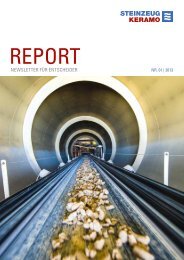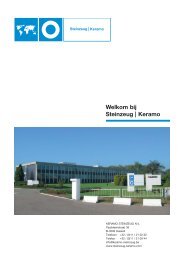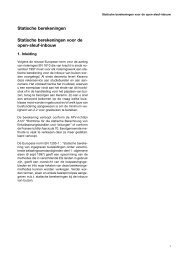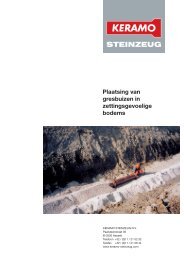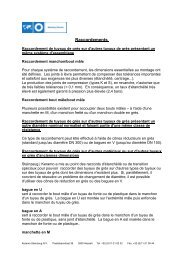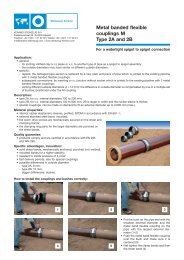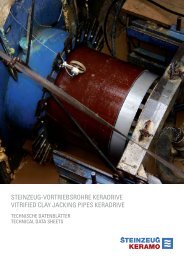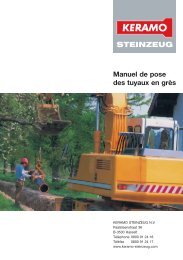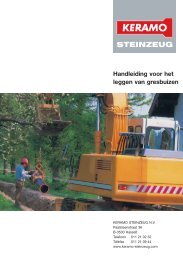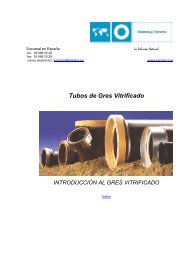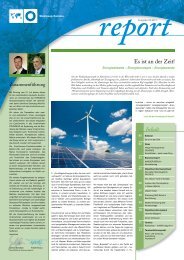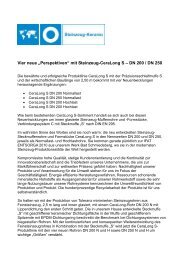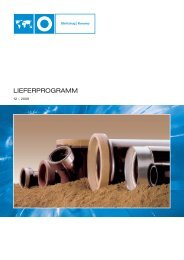mohring engels.indd - Keramo Steinzeug
mohring engels.indd - Keramo Steinzeug
mohring engels.indd - Keramo Steinzeug
You also want an ePaper? Increase the reach of your titles
YUMPU automatically turns print PDFs into web optimized ePapers that Google loves.
The application range generally covers nominal sizes<br />
between DN 200 and DN 1000 and jacking distances up<br />
to max. 100 metres in unconsolidated material. In cohesive<br />
soils of firm consistency extraction and conveying<br />
of the soil can be facilitated by adding water at the face.<br />
In water-bearing soils supplementary measures are<br />
necessary. For use in groundwater up to max. 1.50 but<br />
not more than 2.50 metres the face can be stabilised<br />
with compressed air. The first conveying pipes are for<br />
example fitted with modified augers with a shorter lead,<br />
so that soil plugs form which prevent the compressed air<br />
from escaping. Another possibility is to provide the<br />
starting and target shafts with locks and operate with<br />
compressed air. For this purpose a combined personnel<br />
and materials lock has proved effective which enables<br />
persons and materials to be got into the working area in<br />
separate pressurised chambers. The control console is<br />
installed over the jacking machine and outside the compressed-air<br />
chambers, so that working under atmospheric<br />
conditions is possible here. This compressed-air<br />
alternative is very costly and reserved for special cases.<br />
The method does however have two advantages: firstly,<br />
conveying with augers makes the separation system redundant,<br />
so that no special action is required in severe<br />
frost. Secondly, any recovery necessary at the face of<br />
obstacles to thrust boring and associated operations on<br />
the control head are possible with the compressed-air<br />
equipment available at the site, without need for elaborate<br />
dewatering.<br />
In view of the very successful two-/three-stage jacking<br />
systems using pilot rods and expansion boring in constructing<br />
house connections and nominal sizes for<br />
smaller collectors up to DN 400 a new thrust-bore pipe<br />
jacking system, first demonstrated by Bohrtec at Bauma<br />
’98, should be mentioned.<br />
It is based on two-phase thrust boring and is in initialcost<br />
terms an economical alternative to thrust-bore pipe<br />
jacking used hitherto to install sewers of nominal sizes<br />
between DN 400 and DN 800.<br />
In the first stage of the process a steel casing tube of external<br />
diameter 420 mm with internally fitted augers is<br />
jacked from a starting shaft with unobstructed width 320<br />
cm up to max. 60 metres to a target shaft. The augers<br />
have – like the pilot pipes – a hollow axis and, at the<br />
point of the screw line, a taper. Depending on the position<br />
of this oblique plane relative to the soil at the face,<br />
control movements can be executed during jacking.<br />
This principle of the so-called ”controlled auger” permits<br />
soil conveying also to be optimised with respect to embedded<br />
stone, since the entire cross-section of the steel<br />
casing tube is available for the purpose; the optical<br />
channel runs in the hollow axis of the revolving auger<br />
line, no longer above a separate conveying pipe in the<br />
clearance from the casing tube. Directional accuracy is<br />
again monitored by means of a theodolite with CCD<br />
camera and the monitor in the starting shaft and of the<br />
diode target panel in the control screw. The first stage in<br />
the process is carried out with the same equipment for<br />
all nominal sizes to be jacked and uses a clockwise-rotating<br />
screw line to transport the soil. When the control<br />
auger and first casing tube arrive at the target shaft, the<br />
second stage begins: an expansion stage with directly<br />
driven cutting head is docked on to the end of the line of<br />
steel tubes and, now turning anti-clockwise, conveys the<br />
soil encountered through the steel tube line of the first<br />
process stage to the target shaft. The size of the expansion<br />
stage depends on the nominal size of the<br />
product pipes (Fig. 13).<br />
Shield pipe jacking<br />
Micro-tunnelling Page 13<br />
Fig. 13: Two-phase thrust boring with control<br />
screw, augers and expansion stage, rotating<br />
clockwise and anti-clockwise<br />
Here thrust boring of the product pipes is accompanied<br />
by simultaneous all-over soil removal at the mechanically<br />
and fluid-assisted face by a directly driven cutting<br />
head which is rotating both clockwise and anticlockwise.<br />
In contrast to the machines using auger conveying, with<br />
slurry-conveying machines the soil is transported by a<br />
closed fluid circuit. As a rule the conveying medium<br />
used is water. For loosely bedded, non-cohesive unconsolidated<br />
material use of a bentonite suspension to<br />
prevent uncontrolled soil removal is appropriate. This<br />
type of machine thus lends itself well to coarse-grained<br />
soil types at any groundwater level.<br />
To operate the slurry system a feed pump, normally installed<br />
at ground level, and suction pump in the starting<br />
shaft are needed. By appropriately controlling the two<br />
pumps any pressure required at the face can be set and<br />
thus any water pressure counteracted. Crushers are incorporated<br />
in all slurry systems, so that extracted material<br />
is comminuted to an extent which ensures its subsequent<br />
blockage-free transport through the conveyor



